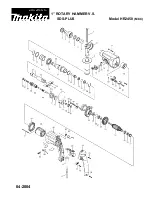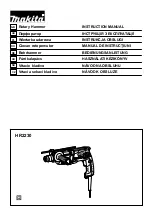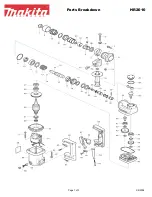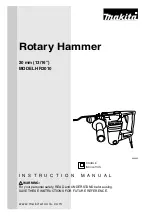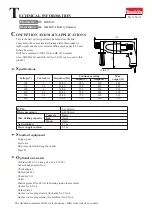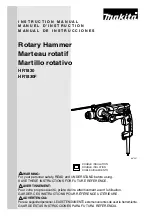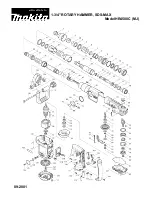
18
| English
moved for transport and storage.
There is risk of injury
from unintentionally pressing the on/off switch.
Auxiliary handle
u
Do not operate your power tool without the auxiliary
handle
(14)
.
u
Make sure that the auxiliary handle is always
tightened.
Otherwise you could lose control of the power
tool when working.
Swivelling the auxiliary handle (see figure A)
You can swivel the auxiliary handle
(14)
to any angle for a
safe work posture that minimises fatigue.
– Turn the lower gripping end of the auxiliary handle
(14)
anticlockwise and swivel the auxiliary handle
(14)
into
the required position. Then turn the lower gripping end of
the auxiliary handle
(14)
clockwise to retighten it.
Make sure that the retaining strap of the auxiliary handle
slots into the corresponding groove of the housing.
Selecting drill chucks and tools
For hammer drilling and chiselling, you will need SDS plus
tools, which insert into the SDS plus drill chuck.
For drilling without impact in wood, metal, ceramic and
plastic as well as for screwdriving, tools without SDS plus
are used (e.g. cylindrical shank drill bits). A keyed chuck is
required for such drilling tools.
Note:
Only use the keyed chuck in the
drilling without im-
pact
operating mode.
Changing the drill chuck
Inserting/removing the keyed chuck
You must use a suitable drill chuck (keyed or keyless chuck,
accessories) to work with tools that do not have SDS-plus
(e.g. cylindrical shank drill bits).
Fitting the keyed chuck (see figure B)
– Screw the SDS-plus shank
(20)
into a keyed chuck
(19)
.
Secure the keyed chuck
(19)
using the securing screw
(18)
.
Note that the securing screw has a left-hand
thread.
Inserting the keyed chuck (see figure B)
– Clean and lightly grease the insertion end of the shank
(20)
.
– Insert the keyed chuck
(19)
with the shank
(20)
into the
tool holder with a turning motion until it locks automatic-
ally.
– Check that it is locked by pulling the keyed chuck
(19)
.
Removing the keyed chuck
– Push the locking sleeve
(4)
back and remove the keyed
chuck
(19)
.
Changing the Tool
The dust protection cap
(3)
largely prevents the penetration
of drilling dust into the tool holder during operation. When
inserting the tool, make sure that the dust protection cap
(3)
does not become damaged.
u
Replace a damaged dust protection cap immediately.
It is recommended that you have use an after-sales
service for this.
Changing the tool (SDS plus)
Inserting SDS-plus application tools (see figure C)
The SDS-plus drill chuck enables you to change the applica-
tion tool easily and conveniently without needing to use ad-
ditional tools.
– Clean and lightly grease the insertion end of the applica-
tion tool.
– Insert the application tool into the tool holder while turn-
ing it until it locks automatically.
– Check the latching by pulling the tool.
As a requirement of the system, the SDS-plus application
tool can move freely. This causes a certain radial run-out at
no-load, which has no effect on the accuracy of the drill hole,
as the drill bit centres itself upon drilling.
Removing SDS-plus application tools (see figure D)
– Push the locking sleeve
(4)
back and remove the applica-
tion tool.
Changing the Keyed Chuck
Inserting the application tool (see figure E)
Note:
Application tools that do not have SDS plus must not
be used for hammer drilling or chiselling. Tools without SDS
plus and their drill chucks are damaged by hammer drilling
or chiselling.
– Insert a keyed chuck
(19)
.
– Open the keyed chuck
(19)
by turning it until the tool can
be inserted. Insert the tool.
– Insert the chuck key
(21)
into the corresponding holes of
the keyed chuck
(19)
and clamp the tool evenly.
– Turn the impact/mode selector switch
(12)
to the
"drilling" position.
Removing the application tool (see figure F)
– Use the chuck key
(21)
to turn the sleeve of the keyed
chuck
(19)
anticlockwise until the application tool can be
removed.
Dust/Chip Extraction
The dust from materials such as lead paint, some types of
wood, minerals and metal can be harmful to human health.
Touching or breathing in this dust can trigger allergic reac-
tions and/or cause respiratory illnesses in the user or in
people in the near vicinity.
Certain dusts, such as oak or beech dust, are classified as
carcinogenic, especially in conjunction with wood treatment
additives (chromate, wood preservative). Materials contain-
ing asbestos may only be machined by specialists.
– Use a dust extraction system that is suitable for the ma-
terial wherever possible.
– Provide good ventilation at the workplace.
– It is advisable to wear a P2 filter class breathing mask.
The regulations on the material being machined that apply in
the country of use must be observed.
1 609 92A 854 | (14.09.2022)
Bosch Power Tools
Содержание GBH 18V-26 D
Страница 3: ... 3 1 2 4 3 6 5 15 7 13 14 11 12 9 10 6 8 14 Bosch Power Tools 1 609 92A 854 14 09 2022 ...
Страница 4: ...4 A C B D E F 4 19 20 14 18 4 19 21 1 609 92A 854 14 09 2022 Bosch Power Tools ...
Страница 5: ... 5 G H 15 2 13 22 Bosch Power Tools 1 609 92A 854 14 09 2022 ...
Страница 252: ...252 1 609 92A 854 14 09 2022 Bosch Power Tools ...
Страница 256: ...IV 1 609 92A 854 14 09 2022 Bosch Power Tools ...































